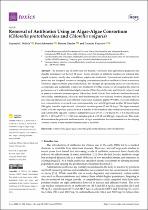 ResearchSpace
ResearchSpace
Removal of antibiotics using an Algae-Algae consortium (Chlorella protothecoides and Chlorella vulgaris)
JavaScript is disabled for your browser. Some features of this site may not work without it.
- ResearchSpace
- →
- Research Publications/Outputs
- →
- Conference Publications
- →
- View Item
| dc.contributor.author |
Ndlela, Luyanda L

|
|
| dc.contributor.author |
Genthe, Bettina

|
|
| dc.contributor.author |
Schroeder, P

|
|
| dc.contributor.author |
Cruzeiro, C

|
|
| dc.date.accessioned | 2023-09-06T08:59:51Z | |
| dc.date.available | 2023-09-06T08:59:51Z | |
| dc.date.issued | 2023-07 | |
| dc.identifier.citation | Ndlela, L.L., Genthe, B., Schroeder, P. & Cruzeiro, C. 2023. Removal of antibiotics using an Algae-Algae consortium (Chlorella protothecoides and Chlorella vulgaris). <i>Toxics, 11(7).</i> http://hdl.handle.net/10204/13034 | en_ZA |
| dc.identifier.issn | 2305-6304 | |
| dc.identifier.uri | https://doi.org/10.3390/toxics11070588 https://www.mdpi.com/2305-6304/11/7/588 | |
| dc.identifier.uri | http://hdl.handle.net/10204/13034 | |
| dc.description.abstract | The intensive use of antibiotics (for human, veterinary, and agricultural purposes) has steadily increased over the last 30 years. Large amounts of antibiotic residues are released into aquatic systems, mostly due to inefficient wastewater treatment. Conventional wastewater treatments are not designed to remove emerging contaminants (such as antibiotics) from wastewater. Therefore, algae treatment (phycoremediation) has emerged as a promising choice for cost-effective, eco-friendly, and sustainable wastewater treatment. For this reason, we investigated the removal performance of a well-established algal consortia (Chlorella protothecoides and Chlorella vulgaris) used in passive wastewater treatment ponds (Mosselbay, South Africa). Five antibiotics (sulfamethoxazole, amoxicillin, trimethoprim, ofloxacin, and clarithromycin) were selected for their ubiquity and/or low removal efficiency in conventional wastewater treatment plants (WWTPs). For each antibiotic, two concentrations were used: one environmentally relevant (10 ppb) and another 10 times higher (100 ppb), tested in triplicate and collected at two-time points (7 and 10 days). The algae remained viable over the exposure period (which is similar to the retention time within maturation ponds) and exhibited the capacity to remove sulfamethoxazole (77.3% ± 3.0 and 46.5% ± 5.3) and ofloxacin (43.5% ± 18.9 and 55.1% ± 12.0) from samples spiked with 10 and 100 ppb, respectively. This study demonstrates the potential and innovation of algal remediation for contaminants in a developing country context, where minimal infrastructure is available. | en_US |
| dc.format | Fulltext | en_US |
| dc.language.iso | en | en_US |
| dc.relation.uri | https://www.mdpi.com/2305-6304/11/7/588 | en_US |
| dc.source | Toxics, 11(7) | en_US |
| dc.subject | Wastewater | en_US |
| dc.subject | Agae-algae consortia | en_US |
| dc.subject | Phycoremediation | en_US |
| dc.subject | Removal efficiency | en_US |
| dc.title | Removal of antibiotics using an Algae-Algae consortium (Chlorella protothecoides and Chlorella vulgaris) | en_US |
| dc.type | Article | en_US |
| dc.description.pages | 12 | en_US |
| dc.description.cluster | Smart Places | en_US |
| dc.description.impactarea | Smart Water Analysis and Solutions | en_US |
| dc.identifier.apacitation | Ndlela, L. L., Genthe, B., Schroeder, P., & Cruzeiro, C. (2023). Removal of antibiotics using an Algae-Algae consortium (Chlorella protothecoides and Chlorella vulgaris). <i>Toxics, 11(7)</i>, http://hdl.handle.net/10204/13034 | en_ZA |
| dc.identifier.chicagocitation | Ndlela, Luyanda L, Bettina Genthe, P Schroeder, and C Cruzeiro "Removal of antibiotics using an Algae-Algae consortium (Chlorella protothecoides and Chlorella vulgaris)." <i>Toxics, 11(7)</i> (2023) http://hdl.handle.net/10204/13034 | en_ZA |
| dc.identifier.vancouvercitation | Ndlela LL, Genthe B, Schroeder P, Cruzeiro C. Removal of antibiotics using an Algae-Algae consortium (Chlorella protothecoides and Chlorella vulgaris). Toxics, 11(7). 2023; http://hdl.handle.net/10204/13034. | en_ZA |
| dc.identifier.ris | TY - Article AU - Ndlela, Luyanda L AU - Genthe, Bettina AU - Schroeder, P AU - Cruzeiro, C AB - The intensive use of antibiotics (for human, veterinary, and agricultural purposes) has steadily increased over the last 30 years. Large amounts of antibiotic residues are released into aquatic systems, mostly due to inefficient wastewater treatment. Conventional wastewater treatments are not designed to remove emerging contaminants (such as antibiotics) from wastewater. Therefore, algae treatment (phycoremediation) has emerged as a promising choice for cost-effective, eco-friendly, and sustainable wastewater treatment. For this reason, we investigated the removal performance of a well-established algal consortia (Chlorella protothecoides and Chlorella vulgaris) used in passive wastewater treatment ponds (Mosselbay, South Africa). Five antibiotics (sulfamethoxazole, amoxicillin, trimethoprim, ofloxacin, and clarithromycin) were selected for their ubiquity and/or low removal efficiency in conventional wastewater treatment plants (WWTPs). For each antibiotic, two concentrations were used: one environmentally relevant (10 ppb) and another 10 times higher (100 ppb), tested in triplicate and collected at two-time points (7 and 10 days). The algae remained viable over the exposure period (which is similar to the retention time within maturation ponds) and exhibited the capacity to remove sulfamethoxazole (77.3% ± 3.0 and 46.5% ± 5.3) and ofloxacin (43.5% ± 18.9 and 55.1% ± 12.0) from samples spiked with 10 and 100 ppb, respectively. This study demonstrates the potential and innovation of algal remediation for contaminants in a developing country context, where minimal infrastructure is available. DA - 2023-07 DB - ResearchSpace DP - CSIR J1 - Toxics, 11(7) KW - Wastewater KW - Agae-algae consortia KW - Phycoremediation KW - Removal efficiency LK - https://researchspace.csir.co.za PY - 2023 SM - 2305-6304 T1 - Removal of antibiotics using an Algae-Algae consortium (Chlorella protothecoides and Chlorella vulgaris) TI - Removal of antibiotics using an Algae-Algae consortium (Chlorella protothecoides and Chlorella vulgaris) UR - http://hdl.handle.net/10204/13034 ER - | en_ZA |
| dc.identifier.worklist | 26972 | en_US |





